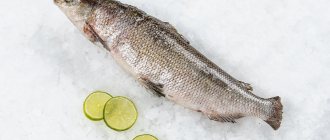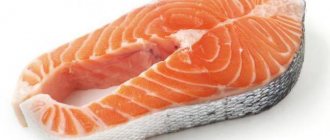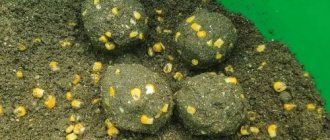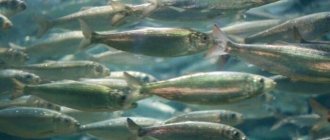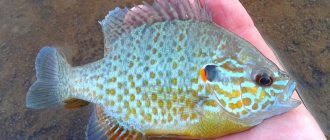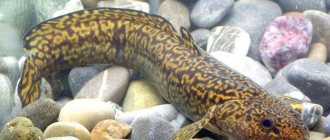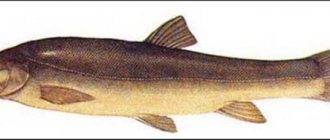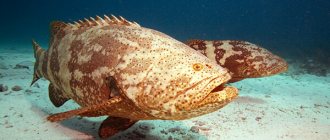Description
Labeo bicolor is a member of the carp family. The body shape resembles a torpedo, slightly flattened on the sides. Large fins are similar to sharks, which is why the fish received the name red tail shark. Adults reach a length of 10–15 cm.
The bicolor's lips act as a suction scraper; the antennae and horny plates around the mouth are adapted for extracting food from any surface.
The black fish with a red tail is the most common subspecies of these exotic carp. But green or white labeo color is also found.
Lifestyle
In nature, they prefer bottom or middle layers of water. Most active in the evening. They move in different ways: crawl along the bottom, swim belly up or vertically. They often jump out of aquariums.
Features of behavior
The character is aggressive and quarrelsome. They prefer solitude. They move at high speed and attack a neighbor they don’t like.
How long do they live?
With proper care, the maximum recorded life expectancy at home is 12 years. The average is 5–6 years.
Rudd, widespread in our reservoirs
Many people, even as children, experienced the thrill of catching a rudd, a fish with red fins and a tail. It is very similar to a roach, only even brighter in color. Fishermen enjoy hunting for rudd; it gives them joy and satisfaction. It is very common in rivers and lakes of Russia. This is especially true for reservoirs in the basins of the Azov, Black, Aral, and Caspian seas. There is a lot of it in Siberia and the Baltic states. The Far Eastern rudd, or ugai, is caught near the Pacific coast. In different regions it is also called red-eyed, red-winged, red-finned roach, roach, roach, and black roach.
The rudd is considered the most beautiful fish in our reservoirs. It is distinguished by a tall body covered with golden scales, orange eyes with a red spot at the top, and pink-crimson fins. Sometimes such beautiful fins reach a length of up to 35 cm. The rudd did not become a commercial fish; some do not like its slightly bitter taste.
Rudd does not like fast currents. It swims into river bays, oxbow lakes, flowing ponds, large lakes and reservoirs. She prefers more remote places than roaches. She prefers placement between reeds, reeds, arrowheads, water lilies and other plants. Here she not only looks for food, but also hides from predators. Smaller fish swim to feed in reed thickets, between bushes and snags. Large rudd prefer more spacious places further from the shore. They swim into underwater hills overgrown with grass.
An angler needs knowledge to hunt rudd. For example, this fish swims to underwater grasses only during the period of their growth and flowering. In autumn, when they wither and decompose, rudd prefers to live near reeds, reeds and horsetails.
You can see a photo of a fish with red fins, rudd, above. She often chooses a spot in a pond and does not swim far from it. In hot weather, rudd swims to the upper layers of water and basks in the sun. This fish feeds on both plant and animal food: plant shoots, insects, larvae. Most of all, she loves the caviar of mollusks laid on the leaves of water lilies.
There are different species of rudd depending on their habitat. She begins to spawn after 3-5 years, when sexual maturity occurs. By the time of spawning, the color of rudd is even more saturated and bright. They hide eggs in aquatic plants in several portions. Sometimes one fish lays about 250 eggs. The incubation period requires about four days, after which the juvenile stage begins.
Varieties of Labeo
Aquarium labeos are divided into several subspecies. The most famous are bicolor and green.
Bicolor
The bicolor was loved by its black, velvet-like body and deep red fins. This subspecies appeared in Russia in 1959. Homemade labeo bicolor grows up to 12 cm.
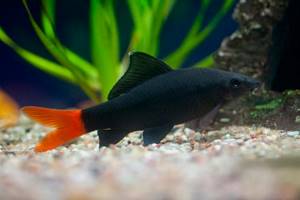
Albino
A variety of Thai green representatives of the species. A distinctive feature is the white color and red-brown fins.
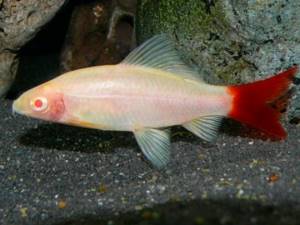
Harlequin or Congolese
The spotted color makes young fish stand out from the crowd. The adult individual acquires a gray tint. Wild harlequin grows up to 30 cm, domestic one up to 16 cm. The fins are soft.

Green
The rainbow labeo has an attractive dark green tint. The abdomen is yellow or silver. The fins are red, like a bicolor. An adult reaches 10–12 cm.

Silver
Less aggressive. During life, they change color from silver in the juvenile phase to dark olive in the adult state.
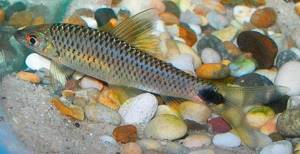
Leopards
In full accordance with the name, the coloring of this subspecies resembles the spots of a leopard.

Black
Rich black color. The largest subspecies. Grows up to 60 cm in captivity and 90 cm in nature. Omnivorous.
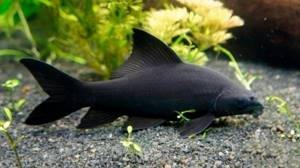
Ancient fish asp
A representative of a special species of Aspius Aspius with red ventral fins is the asp fish. Most of all it is found in water bodies of Western Asia. It lives in large lakes and medium-sized rivers. It is also often found in water bodies of central Europe flowing into the Black, Azov, and Baltic Seas.
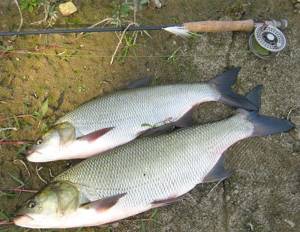
In its family, this redfin fish is the largest. The standard weight of an adult is from 2 to 4 kg. Large specimens reach 8 kg in weight. Even 15-kilogram asps were caught in the Moscow River. This fish has many chewing teeth, small scales, small eyes, and a pointed head shape. The asp has a wide back, shimmering with gray and blue shades. The belly of the fish is white. The eyes are yellow. But the fins are exactly the color we are interested in - gray with red tints.
The ancient fish asp feeds exclusively during the day, entering shallow places. Sometimes on the surface of the water you can see its dorsal fin, reminiscent of a shark. The asp swims at high speed, so it creates waves in the water. A special dish for this predator is small fish. Seeing a school of this fish nearby, an asp can perform real pirouettes in the air. In the early morning you can often hear loud splashes from its tail hitting the water. This is how he stuns his prey. Sometimes he catches fish with his mouth.
Asp is a rather rare fish; it is not grown for industrial purposes. Only occasionally will this beauty be caught in a fisherman’s catch along with other fish. Even online he rarely comes across it, because when he sees it, he immediately turns in the opposite direction. And it’s just very difficult to catch this fish with a fishing rod.
The asp spawns with the onset of winter, as soon as the first frosts begin. If someone manages to catch this beautiful fish, it will be a good addition to the fisherman's collection.
Content
Carps love space and are territorial, so choose the size of the aquarium:
- for double colors from 100 liters;
- for black from 500 l.
If there is insufficient volume and the presence of neighbors, the fish feels uncomfortable.
Be sure to cover the aquarium with a lid to avoid the death of your pet.
Peat water is most comfortable for fish. Place a small nylon bag with fresh peat next to or in the filter. Change the contents 2 times a month.
Water requirements
Bicolors live in clean, fresh rivers. Be sure to provide good filtration, aeration and water changes up to 20% once a week.
At home, create similar conditions according to the following parameters:
- water temperature 22–26 degrees;
- hardness no more than 10;
- acidity 6.8-7.5 pH.
Lighting
Labeos like moderate light, but it causes algae growth. There are two solutions:
- Create a separate container for growing algae and transplant adult plants to the fish.
- Provide good lighting in the main aquarium and shade the bottom with driftwood and large-leaved plants in large quantities.
Equipment
Constantly use a filter and a compressor twice a day for aeration. Leave tap water for 3-4 days before adding.
Interior
When filling your future home for pets, consider the following points:
- equip shelters from driftwood where you can hide;
- create thickets of algae;
- delimit the space into zones using fences made of plants or stones, this will help the cyprinids treat each other more calmly.
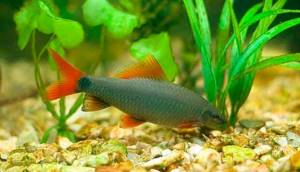
Brook trout
Brook trout is a very unusual fish with red fins. You can see a photo of this beauty above. The back of the fish is covered with black and red spots. Red spots have a light border. The belly and fins of the fish are also red.
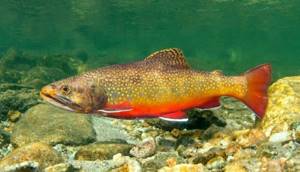
It is found in mountain rivers and streams of Western Europe. In Russia, this trout is found near the Murmansk coast, the Kola Peninsula, in the Volga, the Urals, as well as the rivers of the Crimea, Kuban, Dniester, and Dnieper.
Brook trout spawns in October-November; to do this, it enters shallow water areas with fast currents. For these purposes, it often rises high into the upper reaches of rivers and streams. She reaches sexual maturity after 3-4 years of life.
Brook trout is caught in natural reservoirs, and it is also bred artificially in fish farms. Young fish feed on small crustaceans, insect larvae, mollusks, tadpoles, frogs, and rodents. In reservoirs, trout have competitors in food. Young individuals can also be eaten by pike.
Care
Labeo is practically omnivorous. Reacts only to the state of the water.
Feeding
Labeo aquarium fish eat both live and industrial food.
Choose flakes, granules and tablets based on:
- with a high content of plant fiber;
- sinking - the structure of the fish's mouth is designed to collect food from surfaces.
Labeo loves to eat plankton, tubifex, and fish paste, but the main food for labeo bicolor is plant food.
For vegetables, give the fish scalded pieces of lettuce, zucchini, and cucumbers.
Add oatmeal flakes and egg yolk to your diet.
Periodically place a glass sheet covered in algae into the aquarium.
Distribute food throughout the territory so that each pet has the opportunity to get to it without conflicting with a stronger relative.
Predator pike
The most predatory freshwater fish is pike. Even her body adapted to her agility. This predator is distinguished by a flattened head, a huge mouth, and many small and large teeth. Also, its fins are orange-red in color. Her body is speckled gray-green. It darkens with age. The pike's body shape resembles a long cylinder covered with mucus and small scales. All this so that the fish can move quickly in the water.
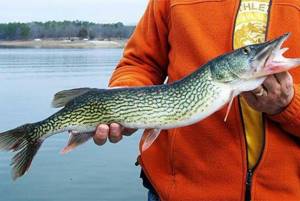
Pike is very voracious; its victims are roaches and perches. But it doesn't end there. Adults exhibit cannibalism; 20% of their diet consists of fry of their own species. Also, these aquatic animals do not disdain reptiles, large insects, various garbage, mice, moles, and small birds.
Puberty of pikes occurs after 3-4 years. The fish begins to spawn in April. To do this, she climbs into the thickets and lays eggs on trunks and leaves. Each female is accompanied to the spawning site by several males. A week later, larvae emerge from the eggs.
Adult pike constantly move around the pond in search of food. Visual and seismosensory orientation helps her detect the victim. These predators do not accept stationary food. Each individual in a reservoir has its own area for hunting. The pike grabs any fish it catches from the head and swallows it. The fact is that this predator's mouth opens very wide. Prey in the stomach can be digested for a week, but the pike still swallows new victims from time to time.
Pike is hunted by many fishermen, and it is also bred industrially. In stores you can buy raw, dried and smoked pike. A photo of a river fish with red fins (pike) is presented above.
Compatibility with other fish
Bicolor is the most aggressive of the species. The aliens to be expelled are mainly fish of a similar color and size, like cichlids.

Compatibility with other labeo fish is possible if the neighbors are smaller, agile, not aggressive and spend most of their time in the layers of water above. Tetras, gours, angelfish and barbs are perfect.
An aquarium with two or more representatives of cyprinids must be zoned so that the fish see each other less often. Equip shelters. When the enemy hides, the carp becomes uninterested in him. The solution is to have more than 4 individuals. Their attention will be scattered and conflicts will be less frequent.
Albinos are much weaker than their wild relatives.
Aquarium barb
So you found out what the fish with red fins (river) is called. Now it’s time to describe aquarium specimens. Some readers are interested in the aquarium striped fish with red fins. We are talking about a barb. You can see it in the photo above. This is a fairly common genus of aquarium fish. They are characterized by bright and varied colors, very mobile, active and not capricious. Many novice aquarium lovers purchase these unpretentious fish with red fins.
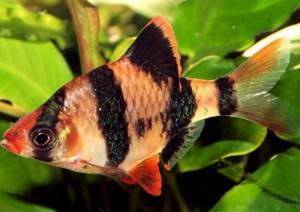
These unpretentious fish were brought from Chinese, Asian and African reservoirs. Beautiful barbs in the wild live in large flocks. There are never any difficulties in maintaining them. They love old water, with a 1/3 change being desirable. A comfortable temperature for keeping them is from 23 to 26°C.
Barbs are very fast and swift fish, so you need to choose the right aquarium for them. It is best to choose an elongated and elongated container where these nimble animals could accelerate. Also, dark soil and bright lighting are important for such aquariums. This contrast can advantageously emphasize the bright color of the barbs. Floating plants will help the fish perform additional maneuvers in the aquarium.
These handsome guys love to live in flocks of 5-7, but sometimes they bully each other. Barbs are bred in separate pairs or groups (1 female and 2-3 males). Females are very fertile and can produce up to 1,000 eggs. First they conduct mating games.
Sometimes the barb is called the “striped robber” because it has an obnoxious character. This restless bully can rush around the aquarium and pester other fish. The handsome little guy is distinguished by his short, tall and laterally compressed body. Its body structure resembles a small crucian carp. Its color is yellowish with silvery tints. On its body there are four distinctive black stripes. The pelvic fins are red, and the dorsal fin is bordered by a reddish stripe.
Reproduction
Breeding labeo fish at home is a difficult task. This is done by specialists in Southeast Asia or local professional aquarists.
Sex difference
It is quite difficult to distinguish a female from a male. Up to a year there is no difference between them. In adulthood, sexual dimorphism is weakly expressed: females have a lighter, rounded abdomen.
When it is necessary to determine the sex of a labeo fish, spawning-stimulating operations are carried out.
Stimulating injections
Natural spawning occurs rarely. To stimulate the process, it is customary for aquarists to carry out hormonal injections.
Without experience and certain skills, it is difficult to make high-quality injections. A dosage error will be fatal.
The injection is given with a thin insulin syringe between the scales on the back.
Popular stimulation schemes:
- The first injection - human chorionic gonadotropin (replaced by Pregnil) is given only to females. The dose is calculated based on the weight of 5–10 mg per 1 g of fish weight; a day later, a second injection is a suspension of the pituitary gland of carp fish dehydrated in acetone - 0.2 mg per 10 g weight for females and 0.1 mg per 10 g weight for males.
- Injection of a suspension of the pituitary gland into a female at the rate of 0.03 mg of the substance per 10 g of body weight, after 24 hours, injection into the female and male at 0.3 mg per 10 g of body weight.
The composition is sold only at fish farms. After spawning, add an antibiotic to the water to prevent infections.
In addition to the described schemes, a less dangerous method is also used, but does not provide a 100% guarantee of spawning. The drug "Nerestin" is administered using a syringe or added to food. It is non-hormonal and sterile; there is no need to add antibiotics after its use.
Before injections or “spawning” fish of different sexes, keep them separately for two weeks.
Male shortage
Labeo bicolor has few males in the litter. To obtain the required number of boys, the fish are bred in large sizes. The situation is complicated by the faster growth of females, as a result of which, when dividing the territory, males often lose and die.
Place the most clogged fry in more comfortable conditions. Most often these babies are male.
Preparation for spawning and spawning
Adulthood and readiness to spawn occurs at the age of 1.5 years. Take 2-3 males for one female.
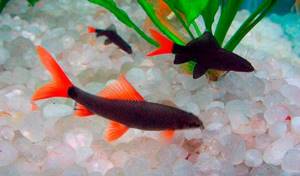
Before spawning, the fish are fed more often and more. Change the water regularly. After the injections, the pets are placed in an oval-shaped spawning tank. Volume from 150 liters, height about 40 cm.
Reduce water hardness to 1.5-2.5.
You cannot lower your temperature after hormonal injections. This is deadly for fish.
Good aeration is maintained in the spawning tank. A pump is needed to ensure a water flow of about 40 m/s.
Plant the container with moss and plants to relieve your pets of stress.
Spawning lasts about half an hour in three stages. Productivity is 3–15 thousand eggs with a diameter of 1.5 mm. Half an hour after spawning, adults are removed. The pump is turned off, the flow necessary for the eggs is maintained by aeration.
Development of labeo fry
This fish is a pegalophile. The eggs ripen in suspension and not on the bottom, which prevents them from being eaten by their parents. The fry mature in 15 hours, after 24 they begin to move and look for food. At this stage of life, pollen from ground particles of algae and ciliates is suitable.
Gradually introduce egg yolk into the diet, and after 7–10 days the finished zooplankton. Such food is sold in specialized pet stores.
Rayfin perch
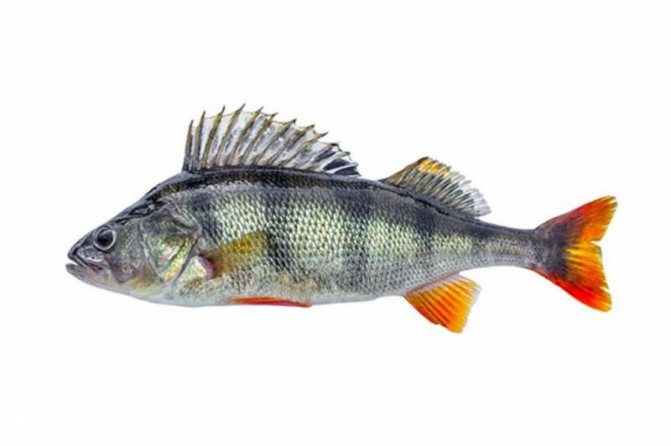
There are a lot of perches in our reservoirs. Their lower fins and tail are also quite bright orange-red in color. On the back of the perch there is a large fin, consisting of two parts - spiny and soft. In the mouth of the fish there are quite large teeth in several rows and fangs. The perch is covered with very small scales, which are difficult to clean; they adhere tightly to the skin. Several dark stripes are visible on the body. River perch can reach 3 kg in weight.
There are several types of perches, their color depends on this. There are individuals with greenish-gray and gray-green coloring. Deep sea fish are characterized by very large eyes.
Perch is comfortable living in freshwater bodies of water with a small current, average depth, and the presence of vegetation. This is a very voracious and indiscriminate predator. He is not averse to profiting from fry, small crustaceans, mollusks, insect larvae, and eggs laid by other fish. Young perches feed on small crustaceans and insects. Grown-up individuals are already tough on small roach and verkhovna. Adult perch feed on sticklebacks and minnows. Sometimes they do not disdain mosquito larvae, crayfish and frogs. To ensure efficient digestion, this predator sometimes swallows small stones and algae.
Perch begins to reproduce at the age of 2-3 years. It spawns in large schools in shallow water. Males fertilize eggs, which hang on plant roots, submerged branches, and snags. The clutch looks like a lace ribbon consisting of 700-800 eggs. The fry appear on the 20th day. When they grow to 10 cm in length, they become predators.
Perches are artificially bred in reservoirs because the fish is very tasty. This fish is so predatory that sometimes, in pursuit of prey, it can throw itself ashore. Small perches are caught much more often than large humpbacks. These fish are comfortable not only in rivers, but also in lakes and ponds. They often destroy valuable fish species such as carp, trout and pike perch. Adults weigh on average about 600 grams. Perch meat is rich in various vitamins and microelements.
Diseases
Disease-resistant immunity. Pets tolerate gradual changes in maintenance well.
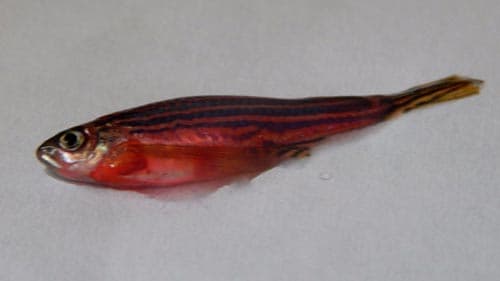
Under stressful conditions, the color loses intensity.
The main reason for poor health is improper care:
- temperature violation;
- low-power compressor;
- insufficient aquarium volume;
- poor quality food.
The most common diseases are dropsy and mucus.
Signs of disease with dropsy:
- bloating;
- sores;
- redness on the abdomen;
- poor appetite.
Signs of mucous skin:
- whitish coating on the body;
- loss of mobility;
- lying on the bottom.
Fish get sick due to fungi, exoparasites and viruses.
At the first sign of illness, remove the fish. Use disinfectants, formalin and feed with broad-spectrum antibiotics.
Omul
Omul is one of the most valuable fish of the salmon family. In 2017, a fishing ban was introduced due to a decline in the species' population.
It is sold smoked and frozen, but is quite expensive. Usually reaches a weight of one and a half kilograms and half a meter in height. The body is elongated, with small scales of an emerald hue, the back is darker.
It is an anadromous fish that lives in the sea, descending into rivers to spawn. Females lay eggs on a sandy or pebble bottom, only in clean, oxygenated water. According to statistics, out of every ten thousand eggs laid, only a dozen fry survive.
The omul feeds on zooplankton, loves larvae, small fish and crustaceans. Does not feed during spawning.
The fish is cunning, fishing for it is very interesting, is a kind of sport and certainly gives pleasure.
It is advisable to use a landing net when fishing and use barbless hooks, since the omul has too thin lips. Various types of flies have proven themselves to work well as attachments.
Fatty and tender omul meat is highly valued in cooking. In addition, it is low in calories, despite its usefulness and nutritional value. It doesn't have many bones. Considered a delicacy.
Many different dishes are prepared from this fish. But there is also an exclusive recipe for which only Baikal omul is used, called “zagutai”. Boneless fillet, skinned, is poured with a brine based on vinegar, salt, oil and seasonings.
Meat marinated in this way is eaten within a few hours.
This fish is found exclusively in cold northern waters of the Arctic. It is part of the order Salmonidae and belongs to the whitefish family. The whitefish is quite large, its body can grow up to eighty centimeters and weigh seventeen kilograms, but the average weight usually reaches five kilograms and a half-meter body length.
There are two types of whitefish – river or lake.
Since the fish is rare, its caviar has a high selling price, which depends on the form in which the product is sold - fresh, frozen or salted. The cost of chir meat is also not the most budget option.
The meat is very fatty, tasty and nutritious, it has few bones. Moreover, it is also dietary, only 88 kcal per hundred grams. A wide variety of dishes are prepared from chir, but smoking and drying occupy the first places.
Source
Reviews
The owners of the fish consider the pet to be the owner. He often jumps out of hiding, scaring his neighbors, but without biting them. Keeping a two-color labeo requires effort, but it pays off with the beauty and curiosity of the fish. Often plays with the owner's hand.
Handsome chub
The chub comes from the carp family and is found in fresh water. Any fisherman considers such a catch a good trophy. Although this is a carp fish, it leads a different lifestyle. This freshwater animal has a beautiful coloring: a dark green back, yellowish sides with silvery tints. The fins on the chest are orange and those on the belly are red. This gives reason to confuse it with another beautiful fish - ide. Only the chub is a larger species. Its weight can reach 8 kg.
The chub is a semi-predatory fish. She loves vegetation, but is not averse to eating small fish, shellfish, worms, and frogs. This fish lives in schools, only very large individuals separate from the schools. Young chub hunt in the morning or during the day, while more mature specimens search for prey even at night. He has well-developed hearing, vision and sense of smell, so he is very timid.

The beautiful chub is not a tasty fish. Its dryish meat contains many thin bones. It is not suitable for frying, but it perfectly complements the fish soup. Many people like dried chub with beer.
Adviсe
- When cleaning, do not move the fish's cover suddenly.
- Do not leave carp in an open space, this will lead to stress.
- Add carp to the aquarium first. Add other fish when the bicolor labeo gets used to it.
- Make sure there is enough food available to avoid fights.
- Place the fish injured in the conflict in a separate container until complete recovery.
- Leave breeding to the professionals.
By following these simple tips, you can enjoy the exotic beauty of your pets for many years.
Benefits and harms of river fish: meat, caviar, milt
River fish contains about 20% protein. Fat ranges from 0.1 to 54%. When determining the nutritional value of fish, not only the amount of fat is taken into account, but also where it is located. There are fish that accumulate fat in the abdomen, liver, subcutaneous layer or at the base of the fins. But the most valuable fish is considered to be the one in which the fat is evenly distributed in the muscles.
Fish from a river or lake is a low-calorie product. On average, its nutritional value ranges from 80 to 90 kcal. Only some types of freshwater fish have a calorie content of more than 100 kcal.
Useful properties of fish
A unique combination of chemical elements contained in river and lake fish helps normalize cardiovascular activity and significantly reduces the risk of cancer.
Harm to river and lake fish
Despite all the benefits, river fish can also pose a potential threat to health. Fish should be consumed carefully, or completely excluded from the diet, by people with a severe allergic reaction. The substances it contains can cause skin rashes.
There are other factors that indicate that fish may be harmful.
Dried and salted fish are harmful to hypertensive patients and people with diseases of the urinary system. Many species of river and lake fish contain many small bones. They can scratch not only the larynx, but also the intestines.
River fish caviar: benefits and harms
River fish caviar is in no way inferior to fish meat in its beneficial properties. In addition to protein, which is contained even more than fish meat, it contains large quantities of vitamins A, B, D, E and a complex of microelements, polyunsaturated acids.
The most popular caviar is pike and crucian carp, but they are in no way inferior to the caviar of pike perch, mullet and roach.
Useful properties of caviar:
One of the popular aphrodisiacs is considered to be dishes using caviar. It not only increases potency, but also improves sex life.
Harm to caviar can be caused by a high salt content, which is harmful for people with diseases of the genitourinary system, or possible allergies.
Interesting: the peoples of the Far North make an energy drink from whitefish caviar. To do this, fresh caviar is mixed with water and salt. The mixture is thoroughly ground. After some time, whitefish caviar completely dissolves, and you get a drink that restores strength.
River fish milk: benefits and harms

This is very important for patients, for example, with diabetes. Regular consumption of milk affects the functioning of the brain and heart, normalizes the level of cholesterol in the blood. Red fish milk is considered the most useful: it contains substances that have antiviral and antimicrobial effects. The sodium salt, which is isolated from milk in laboratories, is used to make immunomodulators.
In medicine, protamine is synthesized from milk, which prolongs the effect of drugs. This is very important for patients, for example, with diabetes
Milk can not only benefit a person, but also cause harm. They are contraindicated for metabolic disorders. It is also not recommended to give milk to children under three years of age due to its high allergenicity.
Interesting: in Finland, milk is valued on a par with caviar. Adding them to the ear is a must.
